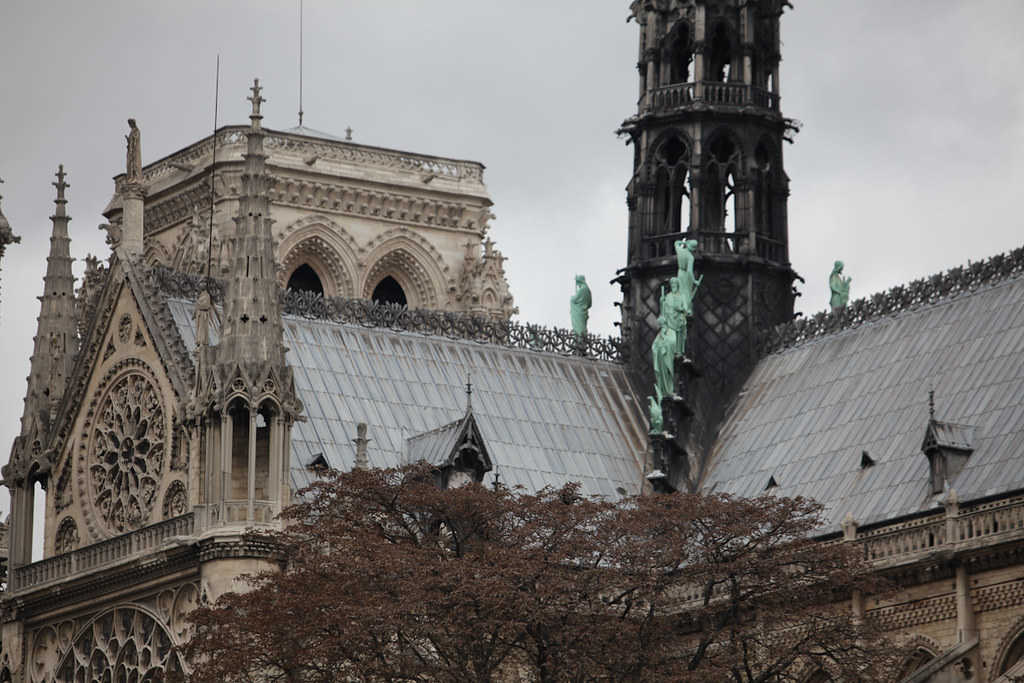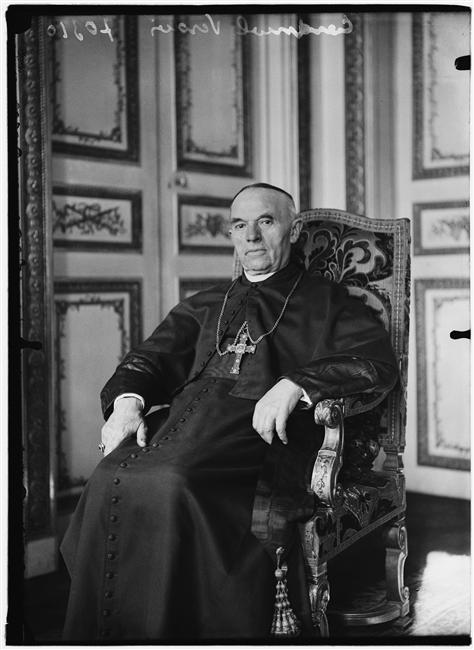




The spire. Photo by Sharon Mollerus, linked below.
The Spire
Viollet-le-Duc, during the restauration work of the Cathedral, decides to build a second spire with a framework independent from that of the forest, resting on an octogonal basis supported by the four pillars of the transept.
In 1860, he entrusts the carpenter Bellu for this work. The model is the one from a two-story spire that was imagined in Orléans in 1852, fundamentally different from the 13th century spire. Furthermore, this spire is not a bell tower.
The spire dominates the green-grayed copper statues of the twelve apostles with the symbols of the four evangelists. Viollet-le-Duc represented himself through the features of St. Thomas and his square. He appears to be contemplating the peak of his masterpiece.
A few impressive numbers: 500 tons of wood, 250 tons of lead, a height of 93m from the ground.
Finally, the rooster at the top of the spire contains three relics: a portion of the Holy Crown of thorns, a relic of Saint Denis and one of Saint Genevieve. It becomes thus a real "spiritual lightining conductor", protecting all of the people working for the praise of God inside the Cathedral, icon of the celestial Jerusalem. It was Cardinal Verdier, the archbishop of Paris, who placed them back in the presence of the chapitre of canons in October 25, 1935. — Literal translation of the official Notre Dame website
Viollet-le-Duc, au moment des travaux de restauration de la cathédrale, décide de mettre en place une seconde flèche dont la charpente serait indépendante de celle de la forêt sur une base octogonale prenant appui sur les quatre piliers du transept.
En 1860, il charge le charpentier Bellu de ces travaux. Le modèle est celui de la flèche à deux étages imaginée à Orléans en 1852 qui s’éloigne fondamentalement de celle du XIIIe siècle. De plus, cette flèche n’est plus un clocher.
La flèche domine les statues de cuivre vert-de-grisé des douze apôtres avec les symboles des quatre évangélistes. Viollet-le-Duc s’est fait représenter lui-même sous les traits de saint Thomas avec son équerre. Il semble contempler le sommet de son « Grand Œuvre ».
Quelques chiffres impressionnants : 500 tonnes de bois, 250 tonnes de plomb, une hauteur de 93 m depuis le sol.
Enfin, le coq situé au sommet de la flèche contient trois reliques : une parcelle de la Sainte Couronne d’épines, une relique de saint Denis et une de sainte Geneviève. Il constitue ainsi un véritable « paratonnerre spirituel » protégeant tous ceux et toutes celles qui œuvrent pour la louange de Dieu, à l‘intérieur de la cathédrale, icône de la Jérusalem céleste. C’est le cardinal Verdier, archevêque de Paris, qui les replaça en présence du chapitre des chanoines le 25 octobre 1935.

Detail of the apostle statues surrounding the spire. Photo by CEA, linked below. The statue looking...

Jean Verdier, PSS (1864 – 1940) was a French Cardinal of the Roman Catholic Church. He served as Arc...

Photo by Pedro Szekely.

On April 15, 2019, a fire struck the cathedral of Notre-Dame de Paris. This timespace guides you through the history and possible future of this Parisian landmark.